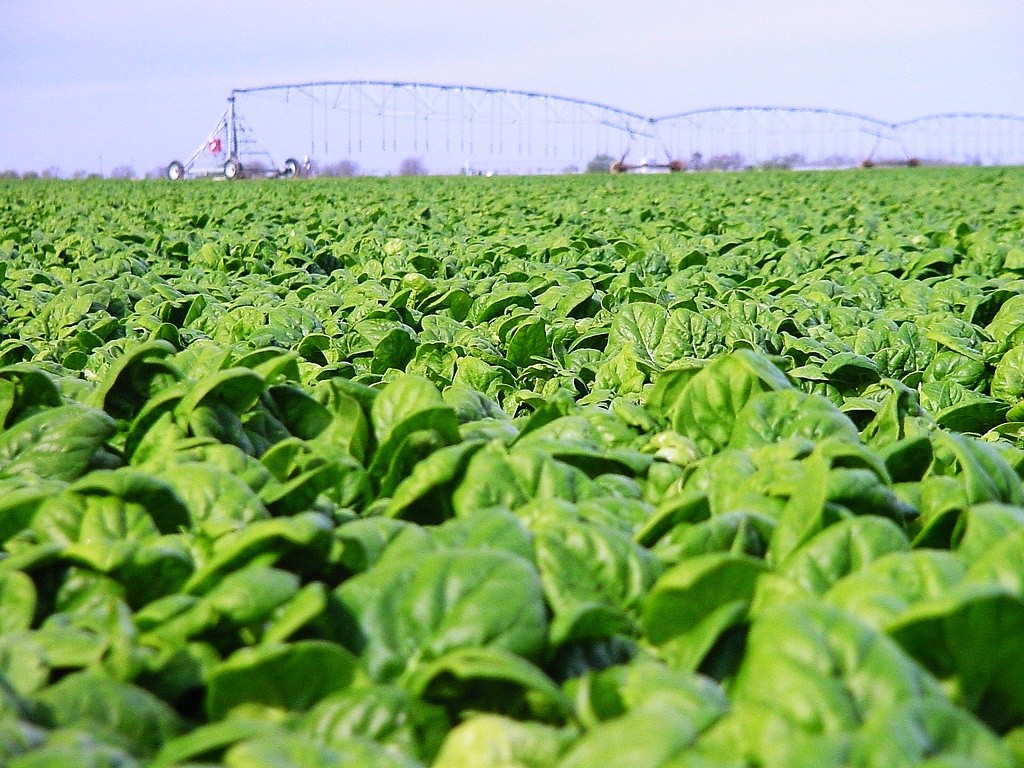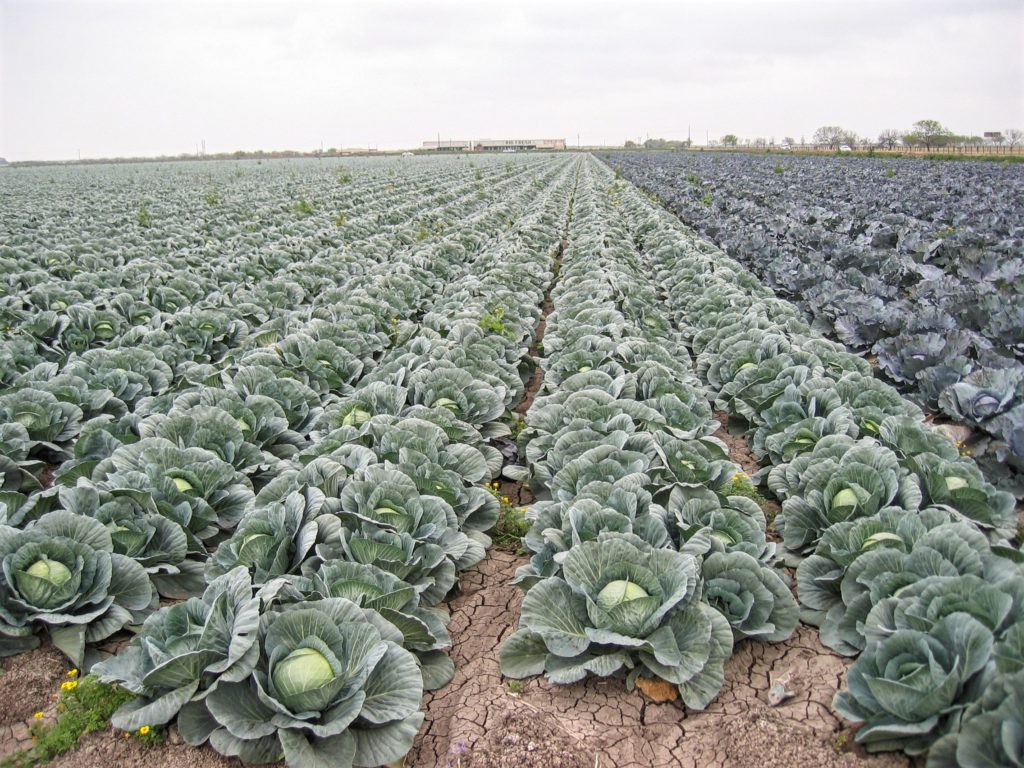Source: AgriLife Today
Conditions were mixed for cool-season vegetable-producing areas of the state, with the Rio Grande Valley and Wintergarden both experiencing weather that led to a less-than-optimal start to the season, according to Texas A&M AgriLife Extension Service experts.
Larry Stein, Ph.D., AgriLife Extension horticulture specialist, Uvalde, said drought conditions in the Wintergarden area continued to stress cool-season crops, including cabbage, spinach and leafy greens. Much of the region had received intermittent and spotty showers but no significant rain since June.

Providing the crops enough water to emerge and grow has been a challenge so far, Stein said. But he reported a good rain arrived late in the reporting period.
“Irrigation helps, but what we’re seeing shows the importance of those late-summer rains to these crops,” he said. “There’s only so much water you can apply over 24 hours with irrigation pivots. You can get so far behind that the pivots just can’t keep up with what the plants need to progress.”
Rain, rain, come our way
Stein said the area received 1-2 inches of rain overnight between Oct. 15-16 with 2.5-3.5 inches of “slow, gentle rain with minimal washing” reported in some areas. Temperatures have also been cooler, which helps plants and reduces evapotranspiration losses, Stein said.
Stein said there is one positive to dry conditions – diseases haven’t been an issue.
“The rains we just received should help farmers catch up on the shortfall of water they’ve experienced over the last three months,” he said.
Typical cool-season varieties in the Wintergarden area include cabbage, spinach, leaf lettuce and leafy greens like kale, chard and arugula, he said.
Stein said growers needed to plant their crops in July so they would be ready for market by fall. Crops like cabbage have been stunted or growing inconsistently in fields.
“Cabbage is starting to grow, but we will probably see a lot of unevenness in the fields related to which rows are getting access to more or less water from the pivots,” he said.
Stein said plantings were strong last year because the market for cabbage was strong. Dry conditions this year could make for a similarly strong market.
The Valley

Juan Anciso, Ph.D., AgriLife Extension horticulturist, Weslaco, said planting in the Rio Grande Valley was stalled somewhat by a rainy September. He said growers utilize irrigation from the Rio Grande River and nearby lakes, so rain is typically not needed and can hurt more than help.
“Producers typically start planting cabbage and celery in early September, and it looked like the first few weeks might delay the crop, but everything got back on track,” he said. “So, on the whole, the rain didn’t delay planting.”
Valley producers grow a wide variety of cool-season vegetables, including cabbage, onions, leafy greens, celery and carrots.
Anciso said it is too early to tell how many acres of cool-season vegetables will be planted in the Rio Grande Valley this season. He suspects it will be as much or slightly more than last year because vegetable prices were strong across the board.
“Growers may shy away from some produce based on prices, but most of them have buyers waiting,” he said. “There are a lot of acres contracted, but growers also have plenty of acres they put on the open market.”
AgriLife Extension district reporters compiled the following summaries:
CENTRAL: Recent rains brought needed relief, but conditions continued to be dry overall. There was some rain in areas. Some locations received up to 2 inches while others received nothing. Some supplemental feeding of cattle began. Cooler temperatures slowed warm-season forage growth. Nearly all counties reported short soil moisture.
ROLLING PLAINS: Pasture and rangeland varied from poor to fair condition. Cattle remained in good shape. Some cattle producers were supplementing cattle with protein cubes. Cotton producers were preparing fields for harvest by spraying boll openers and defoliants on mature cotton. Wheat fields were planted. Armyworms were being monitored.
COASTAL BEND: A cool front brought isolated showers with amounts ranging from zero to 2 inches. Most croplands were disked, and cotton stalks were destroyed. Cotton harvest was near completion in northern parts of the reporting area. There were, however, problems with the second-crop rice, including its being late, narrow brown leaf spot, weak tillering, untimely rains, hogs and birds. Winter pasture planting continued. Some hay was baled. Livestock on limited grazing were being fed hay and protein. Livestock were in good condition, and fall calving continued.
EAST: Most of the district received much-needed rain and cooler temperatures. Some areas, like Smith and Marion counties, needed more rain. Pasture and rangeland conditions were poor to fair. Subsoil and topsoil conditions were adequate. Livestock were fair to good. Prices at cattle markets were lower. Some producers were feeding hay. Armyworms were reported. Wild pigs continued to cause damage.
SOUTH PLAINS: Many areas received some rain with amounts ranging from traces to almost 1 inch. Most counties experienced a hard freeze about three weeks earlier than typical. The freeze may help some producers defoliate, but likely hurt later-planted fields. Some farmers were still waiting for fields to dry out so they can start defoliating cotton. Those with dry fields were busy defoliating mature cotton. Gins were expected to start running soon. The pumpkin harvest was ongoing. Cattle were in good condition. Grains were still being harvested. Producers were digging peanuts.
PANHANDLE: Temperatures fluctuated with a freeze reported across the district. Cotton was opening in southern areas of the district. Maturity for corn and sorghum was 80%-100% across the district. Cotton was in fair to good condition in most areas due to the early freeze. Winter wheat was planted, but little had emerged. Subsoil and topsoil were adequate. Pasture and rangeland were in fair to good condition.
NORTH: Soil moisture was adequate to short across the district. A cool front dropped temperatures into the upper 30s and 40s at night. Sporadic rains were reported throughout the district. Some producers noticed fall armyworms and began spraying. Farmers were spot replanting wheat due to a lack of rain or in some cases replanting entire fields. Livestock looked good for the most part. Calf market prices were below the breakeven point, which left producers waiting for the market to go up.
FAR WEST: High temperatures were in the low 90s with lows in the upper 40s. Spotty precipitation brought 0.5-1.25 inches of rain. The majority of dryland cotton was either being stripped or close to harvest. Some cotton producers were slowed by rain. Most irrigated cotton had bolls opening and was close to defoliator applications. Pasture conditions were still fair. Warm-season grasses will go dormant soon as temperatures continue to fall. Producers were anticipating the upcoming fall weather and making winter preparations. Alfalfa farmers made a final cutting, although some could make a last clipping next month. Pecans looked good with some signs of defoliation. An orchard reported one tree was lost to cotton root rot.
WEST CENTRAL: Conditions were warm and dry. Cotton was in mostly fair condition. Boll size and quality were becoming a concern for many producers. Some cotton fields were being released by crop insurance and destroyed. A few producers began to defoliate fields. Harvest was expected to begin within the next week or so. Winter wheat planting began. Many producers were dry planting fields. Rangeland and pasture conditions were fair to poor. The cattle market opened steady after last week’s price increases on most calves and yearlings. Choice bred cows sold $25-$50 higher this reporting period.
SOUTHEAST: Chambers County was still wet from Tropical Storm Imelda. Some second rice crops might be okay to harvest as soon as conditions dry. In Grimes County, pastures were extremely dry due to the lack of rain and extremely high temperatures. Livestock seemed stressed. Cooler temperatures and rain were expected and should ease livestock and pasture stresses. In Walker County, pastures and forages were holding, although rain was needed. Rangeland and pasture ratings ranged from excellent to very poor with good being most common. Soil moisture levels ranged from adequate to very short with adequate being most common.
SOUTHWEST: Cotton, corn and sorghum were harvested. Preparations for winter forage plantings began. Conditions remained very dry throughout the district. Rangeland and pasture conditions remained poor as well. Livestock and wildlife were still in fair shape with supplemental feeding. Anywhere from 60%-80% of the deer population in Sutton County was lost to the anthrax outbreak earlier in the year. A strong cold front and chance of rain was in the forecast.
SOUTH: Conditions were warm to hot with short to very short moisture levels. Topsoil was powder dry in some areas. A cold front and some accompanying rain was reported in most areas. Temperatures were in the 90s for the most part but reached into the 60s due to the cold front. Kleberg and Kennedy counties reported 2 inches of rainfall on the west side of Texas Highway 77 to 5 inches on the east side of the highway. Cotton harvest was complete, and peanut harvest began in Atascosa County. Large volumes of cotton were stored at gins, and cotton ginning was very active. Producers were busy with cotton stalk destruction. Forages were being harvested, and hay was being fed to livestock. Wheat and oat planting started. Many producers were not planting fall grains due to dry, hot conditions. There were reports of armyworms in pastures. Pasture and range conditions remained fair to poor and supplemental feeding of livestock continued this week. Pecan orchards were in good condition, and some producers expect a great season. Cabbage and spinach made good progress. Beef cattle markets continued to slide downward.
